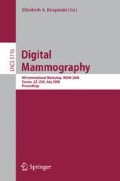Abstract
The appearance of tissue in mammograms is altered by the presence of a mass. Existing mass synthesis methods have not addressed this structural deformation. We present a method for modifying the fine-scale detail in regions of digital mammograms. Regions are decomposed into sub-bands localised in scale and orientation using a wavelet-like decomposition. New structures are synthesised in the high frequency components of the decomposition, leaving coarse levels of the pyramid unchanged. In contrast to existing methods of synthesising mammographic texture, this ensures the global appearance of the region is maintained. Early results in the form of synthesised regions show the promise of this approach.
Access this chapter
Tax calculation will be finalised at checkout
Purchases are for personal use only
Preview
Unable to display preview. Download preview PDF.
References
Caulkin, S.J., Astley, S.M., Mills, A., Boggis, C.R.M.: Generating Realistic Spiculated Lesions in Digital Mammograms. In: 5th International Workshop on Digital Mammography, Toronto, Canada, Medical Physics Publishing, pp. 713–720 (2000)
Highnam, R., Brady, M., English, R.: Simulating Disease in Mammography. In: 5th International Workshop on Digital Mammography, Toronto, Canada, Medical Physics Publishing, pp. 727–731 (2000)
Lado, M.J., Tahoces, P.G., Souto, M., Mendez, A.J., et al.: Real and simulated clustered microcalcifications in digital mammograms. ROC study of observer performance. Med. Phys.1997, 1385–1394
Ruschin, M., Tingberg, A., Bath, M., Grahn, A., et al.: Using simple mathematical functions to simulate pathological structures–input for digital mammography clinical trial. Radiat. Prot. Dosimetry, 424–431 (2005)
Saunders, R.R., Samei, E.E., Baker, J.J., Delong, D.D.: Simulation of mammographic lesions. Academic radiology, 860-870 (2006)
Skiadopoulos, S., Costaridou, L., Kalogeropoulou, C.P., Likaki, E., et al.: Simulating the mammographic appearance of circumscribed lesions. Eur. Radiol., 1137-1147 (2003)
Bliznakova, K., Bliznakov, Z., Bravou, V., Kolitsi, Z., et al.: A three-dimensional breast software phantom for mammography simulation. Phys Med. Biol., 3699-3719 (2003)
Nappi, J., Dean, P.B., Nevalainen, O., Toikkanen, S.: Algorithmic 3D simulation of breast calcifications for digital mammography. Comput. Methods Programs Biomed., 115–124 (2001)
Petroudi, S., Kadir, T., Brady, M.: Automatic classification of mammographic parenchymal patterns: a statistical approach. Engineering in Medicine and Biology Society, 2003. In: Proceedings of the 25th Annual International Conference of the IEEE, vol. 1, pp. 798–801 (2003)
Zwiggelaar, R., Astley, S.M., Boggis, C.R.M., Taylor, C.J.: Linear structures in mammographic images: detection and classification. IEEE Transactions on Medical Imaging, 1077–1086 (2004)
Sajda, P., Spence, C., Parra, L.: A multi-scale probabilistic network model for detection, synthesis and compression in mammographic image analysis. Medical image analysis, 187 (2003)
Rose, C.J.: Statistical Models of Mammographic Texture and Appearance, thesis submitted to University of Manchester, UK (2005)
Simoncelli, E.P., Freeman, W.T.: The steerable pyramid: a flexible architecture for multi-scale derivative computation. In: Proceedings 1995 International Conference on Image Processing, vol. 3, pp. 444–447 (1995)
Berks, M., Rose, C.J., Boggis, C.R.M., Astley, S.M.: Statistical Appearance Models of Mammographic Masses. In: 9th International Workshop on Digital Mammography, Arizona, USA. Springer, Heidelberg (2008)
MacQueen, J.B.: Some Methods for Classification and Analysis of Multivariate Observations. In: 5th Berkeley Symposium on Mathematical Studies and Probability (1967)
Author information
Authors and Affiliations
Editor information
Rights and permissions
Copyright information
© 2008 Springer-Verlag Berlin Heidelberg
About this paper
Cite this paper
Berks, M., Rose, C., Boggis, C., Astley, S. (2008). Synthesising Abnormal Structures in Mammograms Using Pyramid Decomposition. In: Krupinski, E.A. (eds) Digital Mammography. IWDM 2008. Lecture Notes in Computer Science, vol 5116. Springer, Berlin, Heidelberg. https://doi.org/10.1007/978-3-540-70538-3_21
Download citation
DOI: https://doi.org/10.1007/978-3-540-70538-3_21
Publisher Name: Springer, Berlin, Heidelberg
Print ISBN: 978-3-540-70537-6
Online ISBN: 978-3-540-70538-3
eBook Packages: Computer ScienceComputer Science (R0)

